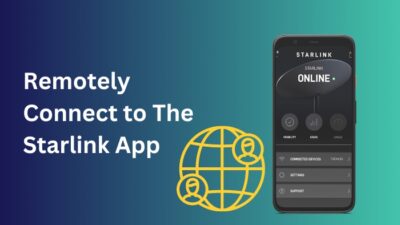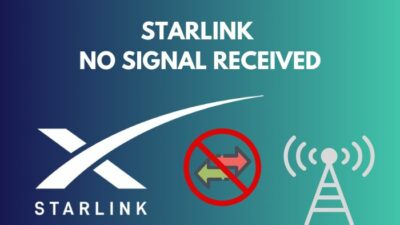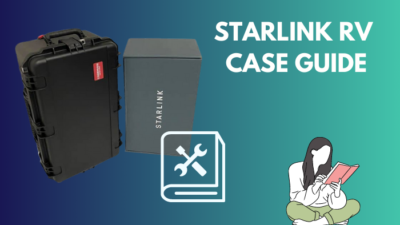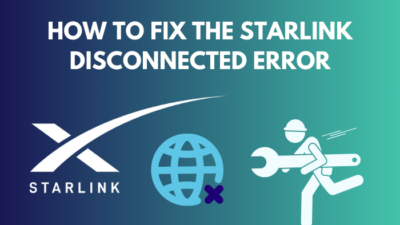Starlink came as a breath of fresh air in the satellite internet industry.
They promised low latency and high-speed satellite internet, which would be a dream come true for people in remote areas.
In the beginning, everything went fine, as promised. Speeds were excellent for a satellite internet connection, and overall connection quality was top-notch.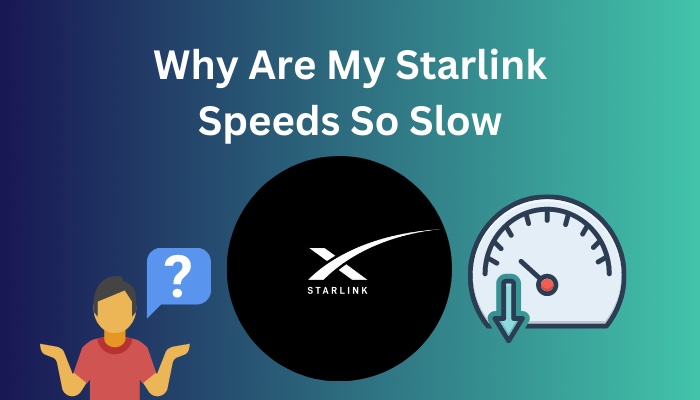
But as time passed, Starlink’s internet speed reduced. Nowadays, many people experience low speed using Starlink.
If you are facing the same situation, this post will explain the reasons behind the slow internet speed of Starlink.
You will also learn some of the approaches to try and improve the situation.
So keep reading the post till the end.
Why Are My Starlink Speeds So Slow?
To understand why Starlink’s internet speed is getting slower daily, you need to know how Starlink works.
Starlink uses low Earth orbit satellites to serve the internet to your place. Typical satellite internet connection uses geostationary satellites located at high altitudes.
These geostationary satellites move at the same speed as the Earth. So a dish antenna can connect with the same geostationary satellite for the whole time.
As the geostationary satellites are located at high altitudes, the internet is slower, and the latency is high.
Starlink tries to solve the problem by using low Earth orbit satellites at low altitudes. But keeping satellites at a low altitude means they cannot move at the same speed as the Earth.
So Starlink builds a constellation of satellites above an area. So a dish can connect to any of the nearby satellites. That’s why Starlink dishes connect to multiple satellites in a day (instead of connecting to one like the geostationary satellites).
A single geostationary satellite can cover a vast region of the Earth. But Starlink low Earth orbit satellites cover small areas due to low altitude.
The challenge is to build a constellation of satellites. Starlink wishes to deploy around 42000 satellites to cover the whole planet. But as of now, only around 3000 satellites have been deployed.
Deploying satellites is a time-consuming task and requires regulatory approval. So it will take quite a while before Starlink’s internet reaches full force.
That’s why Starlink serves the internet in only selected parts of the world (US, UK, Australia, etc.). But since the number of satellites in a region is less than what it should be, the service has degraded than before.
When Starlink was in Beta, the internet speed was pretty fast. As time passed, more people got into Starlink, saturating the satellites and ground stations and causing network congestion.
Starlink tries to control the situation by initiating long wait times on orders. You must wait a long time (several months to a year) on pre-order to get Starlink.
But even that is not helping the situation. The number of users is already more (over 500,000) than the deployed satellites can handle.
Also, check out our separate post on does Starlink internet have data caps or limits.
During off-peak hours, you might get decent speeds. But during peak hours, many users are experiencing slow internet. As Starlink has more users than it can serve in an area, it creates network congestion.
The satellites present above such high-traffic areas cannot respond to all the users, resulting in slower speeds.
Some users report getting speeds below 1 Mbps, which is unusable and below the promised 50-200 Mbps range (of Starlink residential).
Starlink RV degrades the situation more. Starlink RV was introduced to serve better internet to the people roaming around and living in RVs.
Unlike Starlink residential, which works in a fixed location, Starlink RV can be used in any region covered by Starlink satellites.
Starlink RV users are going to already crowded regions, resulting in even worse speeds.
The Starlink dish requires a clear sky view, and any obstructions like trees and buildings will ruin the signal from satellites. Trees may have grown, or other obstructions have been created since the last time you checked.
So newer obstructions can also cause slow speeds. Rough weather conditions can damage the Starlink dish or the cables.
If you are using the Starlink-provided router in a big place, there is a good chance of getting slower speeds. You need a mesh router solution to get a better internet connection across a big place.
How Fast Is The Starlink Internet?
Starlink is a satellite internet connection. So it is not meant to rival the broadband internet connection. Instead, it aims to provide decent internet in remote areas.
As of now, Starlink has 4 types of plans: Residential, RV, Business and Maritime.
Starlink residential plan users should get 50-200 Mbps download, and 10-20 Mbps upload speed. Starlink RV users get slightly less while Business users get the most.
Here is what Starlink promises to its users across the different plans:
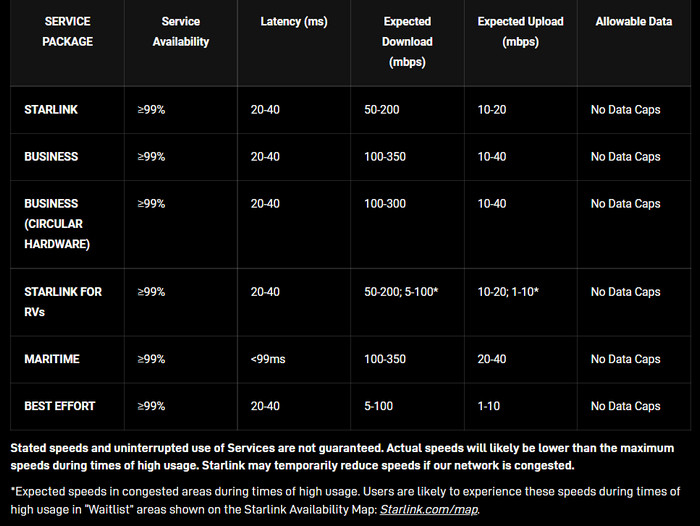
Ookla published a report on the Starlink internet performance in September 2022. Ookla generated the report based on the speed tests performed on their platform.
The report says that “Starlink speeds decreased in every country we surveyed over the past year as more users sign up for service.”
More specifically, median download speeds dropped by 9-54% across different countries.
As more people get into Starlink internet and buy the different plans, the congestion is only increasing.
Go and check our other article on Starlink for gaming-is it good or bad.
How To Fix Starlink’s Slow Speed
Starlink’s slow speed is mainly caused by network congestion. While you cannot fix the network congestion, you can take some steps to detect and fix the other reasons that cause slow speeds.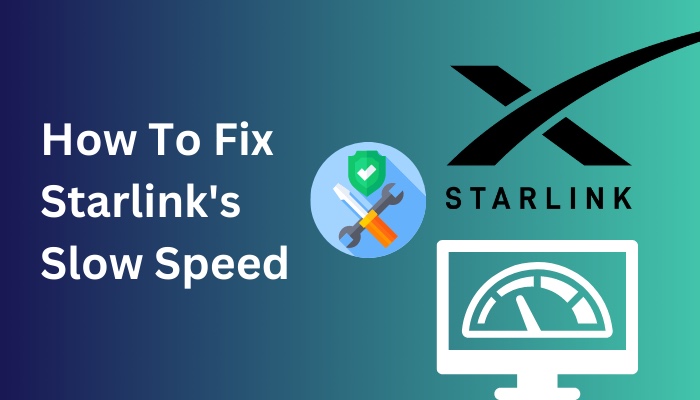
Follow the steps below to fix Starlink’s slow speed:
- Do speed tests during peak and off-peak hours to ensure it is no network congestion. Peak hours are usually 5 PM to 10 PM. It is not network congestion if you get slow speed on both peak and off-peak hours.
- Check if you have a decent WiFi signal. Perform speed tests standing next to and away from the router. If the speeds vary a lot, you need to buy a mesh router to ensure the WiFi signal covers the house. You can also open the Starlink app and use the Range option to check WiFi coverage.
- Contact Starlink support and ask them to check the Starlink hardware like dish and router. Starlink support can remotely check the different components and look for any damage or error. So if you have any suspicion regarding damage, feel free to ask Starlink support.
- Open the Starlink app and go to Network to view the WiFi strength next to each connected device. Bring the device with poor WiFi strength close to the router and check the speed difference. If the difference is substantial, you either need to bring the device close to the router or buy mesh routers.
- Use an Ethernet cable to connect to the router and see if it improves the speed. Remember that the router coming with the newer rectangular dish does not have an Ethernet port. So this option is only for users of the circular dish.
- Ensure to turn on Bypass Mode into the Starlink router if you are using a third-party router.
- Check if any device is consuming bandwidth in the background.
- Check if any newly grown trees or other obstructions to the dish are present. If so, remove the obstructions.
Going through the above steps one after another can help you detect any networking problem with Starlink internet and fix it.
How Starlink Is Responding To Slower Speeds
Though there is no official statement from Starlink regarding the slow speed, they are aware of the issue. Starlink support acknowledges the slow internet speed, as seen on several customer support chats that surfaced online.
Starlink support points toward network congestion in certain areas during peak hours. They think the problem will disappear once the entire satellite constellation is in action.
Starlink has a limited number of satellites in deployment. Hence when the user base in an area crosses a specific limit, the satellites cannot respond to all the users.
So Starlink has limited the number of users in an area. But the situation got out of control when they launched Starlink RV, a satellite internet connection for use in any place.
So RV dwellers and people traveling frequently buy Starlink in one area, then move into an already saturated area, disrupting the limit. Starlink RV also bypasses the long wait list of the residential plan, further increasing congestion.
Some Starlink RV users are operating Starlink while moving, which is not something Starlink officially supports (even though FCC approved it). It causes disturbance in the signals in an area.
Starlink has been developing Version 2 of Starlink satellite for a while now. It has improved; new antennas will work with more bandwidth and offer better connection quality.
But the Version 2 satellite weighs a lot more (about 5x) than the original one. As such, the rockets used to deploy older satellites (Falcon 9) won’t work.
SpaceX is developing a new rocket named Starship to launch the next-generation satellites. But it is still under development and needs quite a while. The newer satellites also did not go through extensive testing, so some variables exist.
If Starlink can get the new rocket Starship and the new satellite Version 2 working together, it will play an essential role in mitigating the slower speeds.
Check this article about How Long is the Waitlist for Starlink.
Final Thoughts
Starlink Internet brought a significant change in the satellite internet industry. However, quality degraded over time with increased users.
Oversell of the Starlink connection caused network congestion which is the primary reason behind Starlink’s slow speeds.
Other reasons include the WiFi not reaching everywhere, the dish getting obstructed, and damaged hardware.
You cannot do anything regarding network congestion. But if other reasons cause slow speed, you can attempt to fix the problem.
